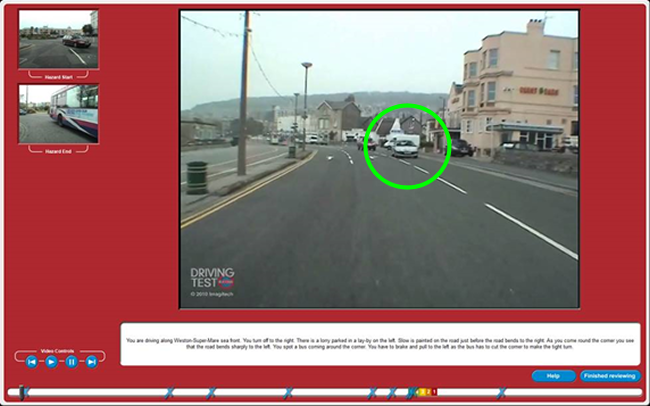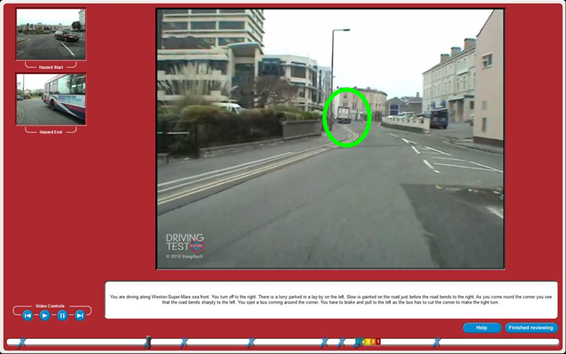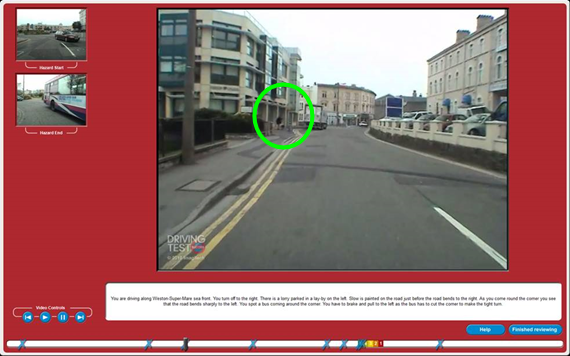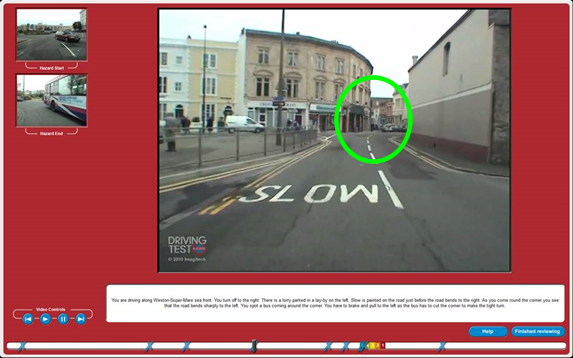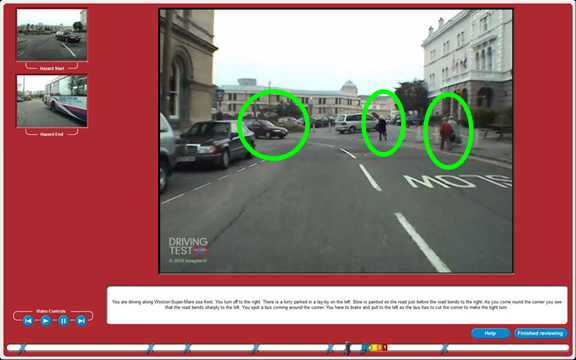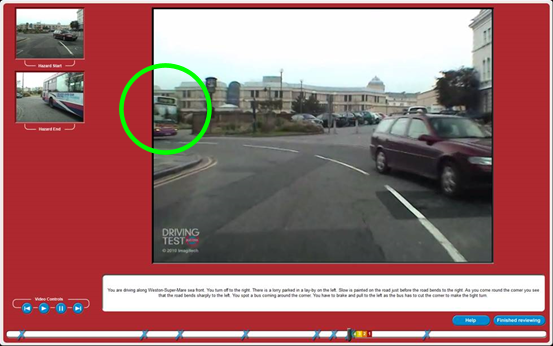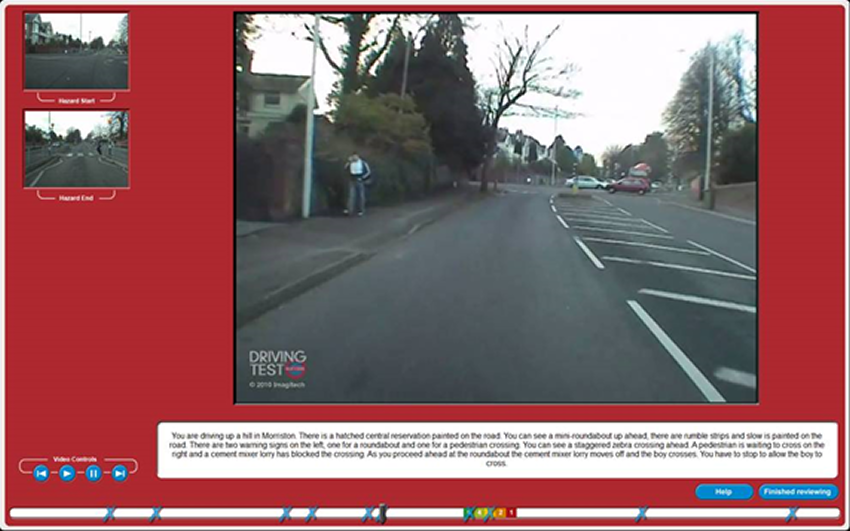Doing the tests
 On this page we explain how to complete the tests with advice on identifying hazards and when to click. We explain the thought process with a series of stills taken from one of the tests on the DVD.
On this page we explain how to complete the tests with advice on identifying hazards and when to click. We explain the thought process with a series of stills taken from one of the tests on the DVD.
Because some of the videos are not very high resolution* you need to concentrate hard - however, one of the most common reasons for late clicks is that people don't look 'deep' enough into the shot - this is also a very common problem when driving with drivers not looking far enough ahead (as many students discover during Part-Two training!).
*Some HPT videos are now computer generated, these are much higher resolution making some hazards clearer - but at worst, the older clips are no worse that the view a driver would get in moderately poor weather conditions and so should not cause a problem.
The stills will give you an idea about where you need to be looking.
Another common issue is that ADI students (and learners) tend to wait for something to happen before they click. Each video clip will have several hazards - but not all of the hazards will develop. However, because you don't know which of the hazards will develop it's important to click as soon as you are aware of a POTENTIAL problem, that is, that you can perceive potential dangers BEFORE they develop.
10 second intro
The 10 second introduction to each clip gives you an opportunity to get an idea about what sort of road you are on and what is likely to happen. This is useful because it alerts you to the kinds of hazard that you might expect to see.
In our example we show an 'in town' clip. Town centre hazards might include:
- Buses and bus stops
- Pedestrians and crossings
- Vans and drivers (where there’s a van –there’s a man)
- Lorry’s taking up road space
- Cyclists
- Lots of junctions
What does your own driving experience tell you about town driving? What will you be looking for?
Examples
The examples below show eight hazards - six are clicked once and one is clicked twice. Because you are scored on 'developing hazards' it's important to click as soon as you spot something that might affect you. If you wait until the point at which you would be braking you are seeing the hazards too late.
1. Van emerging
In the still below you can see a white transit van coming out of road on right. CLICK
There is no second click for this because it doesn't affect our speed or direction (but always think – where there is one there could be two, expect a second vehicle to follow the first and be prepared to click again).
You only get a score for 'developing hazards' in some situations like this you will click but the hazard will not develop. However, at this point it is a potential hazard and you don't know whether or not it will develop - hence the click.
2. Parked van
There is a van parked on the left. CLICK
There is no 2nd click because there is no change to speed or direction.
Notice that we are now on narrower streets with blind bends- what is likely to happen?
3. Man with dog
Man with dog on the path - might step out. CLICK
But again, no change to speed/direction and so no 2nd click required.
4. Changing situation
Here there is a man on the corner- he might step out (this is easier to see in the actual video clip as opposed to this screen shot).
The road is also narrowing down so may be problems with vehicles coming other way/pedestrians/ parked vans/bends (potentially a narrow meeting situation). CLICK
The road is clearly marked with SLOW - ask yourself why.
5. Approaching vehicles
We can see a car appearing from left - if there is one there may be more. Will it move into our path by cutting the bend? CLICK - again only one click as nothing starts to delevlop.
6. A lot going on!
As the road goes to the left and the approaching car cuts the bend - although this car is not a problem for us it's reasonable to expect another one that could affect us, especially with pedestrians on the right who could step into the path of the oncoming traffic.
A simple rule to follow is "where there’s one there’s two" – if one car pulls out of a side street another is likely to follow, if one car cuts the bend, expect another! CLICK
7. It's a bus...
A bus appears. Given that the car cut across the bend, the bus almost certainly will and if it does we will have to take action. This is an example of a situation where a second click will be required as the hazard develops and the bus cuts across.
CLICK when you see the bus and then CLICK again as the hazard starts to develop. (Do not click again for hazards that don't develop.)
By clicking twice here you guard against the risk of clicking too soon. Having said that, there have been lots of clues - in situations like this the first click will usually score top marks. If you slightly miss top marks with the first click (it is possible to click too soon) the second click will either score 5 or 4 points.
8. Pedestrians
Pedestrians in the road ahead - might be gone when we get there, but might be having a party! CLICK
Important!
Experienced drivers tend to see potential dangers before they happen - this can lead to clicking too early - hence the 2nd or even 3rd click when things develop (clicking more than three times for a hazard can lead to the system thinking you are cheating with repetitive clicks - this is why we normally advise 2 clicks only for any given hazard.
The screen-shot below shows an example of a situation where an experienced driver might click to early.
In this clip we are approaching a mini-roundabout but beyond the roundabout is a crossing where there is activity, you can see a cement mixer in the screen-shot - this is blocking the crossing. When the cement mixer moves a pedestrian crosses the road and we have to stop.
For a keen eyed, experienced driver who is looking well ahead into the clip it would be easy to click too soon for this situation, however, if you were to do this, a 2nd click should get you a good score.
While it is possible to click too soon, our experience is that if anything, most students who are new to HPT are more likely to click too late.
Useful tip for timing: Mirror - Click
As soon as you see a hazard on the screen, mentally make a mirror check and click the mouse as you do so – you can follow this up with one or two more clicks for the same hazard. Just as you would use your mirrors more than once for any given situation on the road.
The sequence on the road is:
- Mirrors on spotting the hazard
- Mirrors before minor adjustment of speed (easing off)
- Mirrors before signal consideration
- Mirrors before significant speed adjustment
- Mirrors before position changes
By considering your clicks this way, the mental mirror check will help avoid the risk of your first click being a fraction too soon, with the backup guarantee that you will still get a mark for your second or third click.
Next: Step 5 explains the importance of the Hazard Perception Test for learners and gives a little more information to help you complete the tests.
